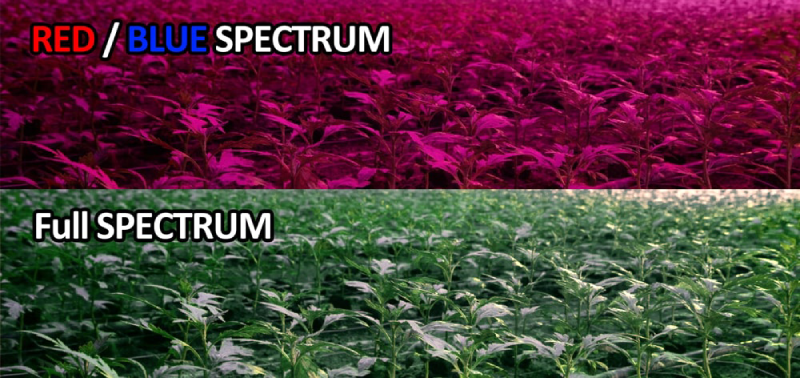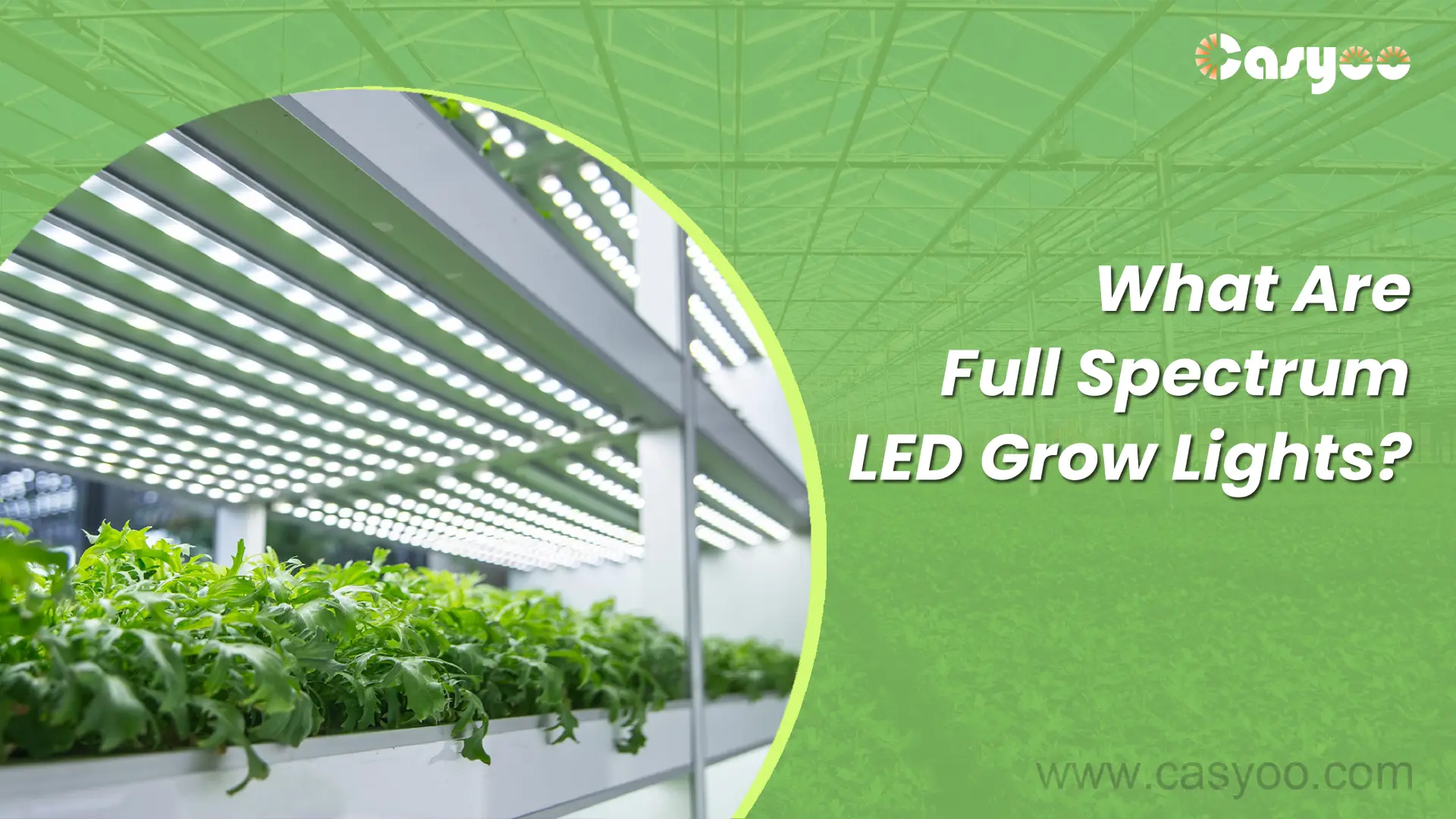With their unparalleled energy efficiency and capacity to replicate natural sunlight, full-spectrum LED grow lights have emerged as an indispensable tool for horticulturists across the globe. But what does this “full spectrum” mean? Why is it so important to indoor growers? What’s different about traditional spectra?
Traditional LED grow lights vs. full spectrum: what’s the difference?
Full spectrum LED grow lighting
The full spectrum refers to the light covering the entire wavelength range required for photosynthesis, which refers to the visible range of 400-800nm, including a part of the infrared spectrum. This type of light is very similar to natural sunlight and provides the light energy necessary for plants to carry out metabolic processes. Some people think that “full spectrum” should refer to the entire spectrum emitted by the sun, which includes a wider spectral range of 300-2500nm. But this is a different concept.
Full spectrum LED grow lights for indoor plants are mainly used in the greenhouse, laboratory or outdoor poor lighting conditions, simulates the solar spectrum, and increases the red and blue components of the visible light spectrum to improve plant photosynthesis. It can be used in:
- Crop cultivation and phenotypic analysis of different growth stages, phenotypic big data database construction
- Speed breeding, stress physiology and resistance screening
- Photobiology research
- Imaging analysis of pigments and secondary metabolites of crops such as vegetables and medicinal crops
- Plant factory, vertical framing, greenhouses
- Smart agriculture, digital agriculture simulation, experimental research
Traditional LED grow lights
Traditional LED grow lights usually contain blue and red LEDs. As a result, you can see a purple light. The red and blue grow light works on the principle that plants photosynthesize most efficiently in red and blue wavelengths. However, the red and blue wavelengths only take up a small portion of the entire visible spectrum.
Here raises the question: if red and blue light are the most efficient for photosynthesis, why should we be concerned about other wavelengths? The answer is that other wavelengths can affect other processes within the plant, which in turn affects the growth of the plant. This might mean higher quality plants or higher nutrient content.
Full spectrum LED grow lights vs traditional grow lights comparison
|
Aspect |
Traditional LED Grow Lights |
Full-Spectrum LED Grow Lights |
|
Spectral Range |
Narrow spectrum (mainly red ~660nm and blue ~450nm) |
Broad spectrum (400-800nm, including visible and some infrared light) |
|
Light Color |
Purple (due to red and blue light combination) |
White (similar to natural sunlight) |
|
Plant Growth Support |
Focused on photosynthesis, limited support for other processes |
Supports photosynthesis, morphology, flowering, and nutrient synthesis |
|
Application Scenarios |
Suitable for specific growth stages (e.g., seedling, flowering) |
Suitable for full growth cycle, greenhouses, plant factories, labs, etc. |
Conventional LED technology operates at set wavelength spectrums yet full spectrum LEDs establish broad wavelength coverage supporting plants from growth to flowering and eventual fruit development.
Full spectrum LED grow lights also provide cultivators adaptable spectrum control capabilities for changes that align with the specific requirements of different plant development phases.
How do full spectrum LED grow lights affect plant growth?

- Ultraviolet light(280-315nm): suppresses the growth of all kinds of plants and even fungi
- Far ultraviolet light(315-400nm): chlorophyll absorption is low, preventing stem elongation
- Blue light(400-520nm): promotes the development of plant roots and stems
- Green light(520-610nm): green pigment absorption rate is not high
- Red light(610-720nm): has significant effects on photosynthesis and plant growth rate
- Infrared(720-1000nm): has a low absorption rate for plants, and stimulates cell elongation
The wavelengths produced by Full-spectrum LED grow lights affect plant growth through various spectrums. While ultraviolet light suppresses growth and limits stem elongation, blue light encourages root and stem development. Red light greatly boosts photosynthesis and growth. Green light and infrared light have a low absorption rate for plants, but infrared light may stimulate cell elongation.
Are full spectrum LED grow lights harmful to the human body?

People who use grow lights know that they have great benefits for plants. Gardeners usually use red and blue light, because red and blue light are the most effective wavelengths absorbed by plants, so it has great benefits for promoting the growth of plant stems and leaves, flowering and fruit. However, they miss the harm brought by red and blue light to the human body.
Take red and blue LED plant light as an example, the light emitted is purple. If people work in this environment for a long time, they will feel dizzy, nauseous and vomiting, so only when no one is available in the growing environment, will the farmer turn on this kind of light.
At the same time, it is worth noting that the full spectrum LED not only has a good effect on plant growth, but also has no damage to the human body. It emits white light similar to the sun, so no situation will make people dizzy and nauseous.
Full spectrum vs. red and blue grow lights: which one should you choose?

LED grow light bead chips mainly have red light beads, blue light beads, full spectrum lamp beads. Red light regulates the plant photoperiod, affecting the plant’s flowering and fruit, while blue light encourages the growth of stems and leaves. Red and blue grow light only have these two colors in light while the full spectrum grow light mimics sunlight, emitting white light. Both of them can promote plant growth, but different plants may require specific wavelengths of light in different growth stages. For example, suppose that you are growing lettuce. People eat the stems and leaves of lettuce. So you should choose a spectrum that promotes the the quality and yield of stems and leaves. Thus, in this case, blue light can help. Generally speaking, for fruiting crops and flowers that need to be colored, you should use red and blue grow lights.
Full spectrum grow lights can be used for leaf vegetables. If you grow indoor plants, a full spectrum light is a better choice, because the light of the red and blue lamp is purple and uncomfortable to look at.
All in all, choosing full spectrum grow light or red and blue grow light should take into account the spectral needs of plants, light efficiency and growth stage. However, if budget permits, full spectrum grow lights are always a better option. You can shift the spectrum in different growth stages to suit the plant’s needs.
How to choose the best full spectrum LED grow lights for indoor plants?
To find the optimal full spectrum LED grow lights for your plants, you should evaluate various critical elements that determine both efficiency and optimal plant growth, which include:
- PPFD: The amount of usable light that plants receive is determined through measurement of PPFD. For most plants, a PPFD of 200-400 μmol/m²/s is suitable for vegetative growth, while 600-900 μmol/m²/s is ideal for flowering stages.
- Light Uniformity: It is vital to choose lighting solutions which maintain uniformity across the plants with a PPFD standard deviation below 20%.
- Heat Management: The effective dissipation of heat stands as a priority to prevent overheating conditions which protect the life span of LED lights. The selection of lights that employ heat sinks or fans will help reach optimal operating temperatures.
- Brand and Quality: Choose brands which customers trust due to their reliability record and high quality standards. You can check the comments to know the performance of the light and then look for its warranties and certifications.
Best full spectrum LED grow lights recommendation
- Leoter grow light
Each stage of plant growth finds support from Leoter grow light through its complete spectrum which ranges from 380nm to 800nm. Most lethal to plants are specific wavelengths of red and blue light at 660nm red and 460nm blue during their flowering and fruiting cycles. The light is equipped with an aerospace-grade heat sink to prevent the lamp from overheating.
- LBW LED grow light
A full-spectrum lighting solution in LBW LED grow light spans from 380nm to 800nm through combinations of high-quality blue light, red light, warm white light and cool white light LEDs for effective sunlight simulation. The lamp is easy to install, and most buyers notice significant improvements in their plants’ growth after using it.
Frequently asked questions
Q: Are full-spectrum LED lights good for growing plants?
A: Yes, full-spectrum LED lights emit a balanced spectrum containing natural wavelengths which foster growth development during every plant cycle. These grow lights provide an efficient solution for indoor gardening because they suit individual requirements while being energy-conscious.
Q: How long do full-spectrum LED lights last?
A: Full-spectrum LED lights operate for an exceptionally extended period at 50,000 to 100,000 hours.
Q: Are full-spectrum grow lights safe for humans?
A: When used appropriately full-spectrum grow lights create no harm to human beings. However, one should avoid direct exposure to strong light for an extended period since this will lead to eye strain.
Q: How do you use a full-spectrum grow light?
A: The optimal height to position a whole spectrum grow light above plants should range from 12 to 24 inches to achieve appropriate lighting levels without overheating the plants. Set the time schedule for LED lighting in accordance with your plants’ current developmental stage.
About us
For more than 17 years, Casyoo has been developing exceptional LED grow lights for your healthy plants. Our lights have everything growers need to maintain a productive and vibrant growing space. If you want to grow healthy plants on an unprecedented scale, visit our website today!




